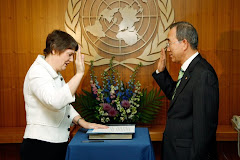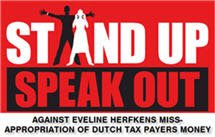UNDP admits vehicles registered in its name were used to smuggle diamonds
The United Nations Development Programme has finally admitted that vehicles registered in its name were used to smuggle diamonds from River Ranch Mine near Beitbridge into South Africa but claims that the vehicles were fraudulently registered.
It does not say who fraudulently registered the vehicles -UNDP staff in Harare, River Ranch Mine, or UNDP accredited staff seconded to the miningcompany through African Management Services Company (AMSCO), a company that the UNDP jointly owns with the International Finance Corporation (IFC) and the African Development Bank.
The revelation could have serious repercussions on the credibility of the Kimberley Process Certification System (KPCS) -a system that was introduced to stem the flow of "blood" and illicit diamonds into the world market- because a KP team that visited the country in 2007 ruled that there was no smuggling from River Ranch.
A Bulawayo-based mining company, Bubye Minerals, has insisted over the past three years that UNDP registered vehicles were used to smuggle diamonds from River Ranch Mine, which it claims it still owns, but the UNDP office in Harare has flatly denied the allegations.
Bubye Minerals is involved in an ownership dispute with River Ranch Limited which took over the mine in 2004. The mine was originally owned by Auridium Zimbabwe - a company that was jointly owned by Australian and Canadian investors- but it went into voluntary liquidation in 1998.
Bubye Minerals took over the mine through a Deed of Compromise in 1999, but was kicked out by Saudi Arabian billionaire, Adel Aujan who Bubye had invited to assist in buying out the foreign shareholders of Auridium. Aujan invited Kupukile Resources, which is owned by former army commander Solomon Mujuru and his business associate Tirivanhu Mudariki, to join him.
The UNDP says that three internal investigations it carried out cleared the organisation of the smuggling allegations. A fourth investigation was carried out by an independent expert, Frank Dutton, a former South African police officer who founded the crack Scorpions unit. Dutton was hired by the UNDP head office in New York in July last year to carry out a six month investigation into the operations of the UNDP office in Harare. He completed his report in January but the UNDP has refused to release the report.
"We do not share investigation reports, regardless of their outcome," it says in a statement
obtained through a Capitol Hill staffer. "This is - among other things - to preserve the due process rights and the reputation of a staff member who may have been accused of wrongdoing. Disclosure of investigators' reports could result in irreparable harm to a person accused, but against whom no subsequent disciplinary action may be warranted".
"UNDP has indeed investigated the accusation of collusion in diamond smuggling in Zimbabwe," it said.
"The allegations were found to be unsubstantiated. On the particular accusation that UNDP vehicles were used to smuggle diamonds, the investigation found that those vehicles were fraudulently registered in the name of UNDP."
Bubye Minerals' lawyer Terrence Hussein said the statement by the UNDP, which has been confirmed by another source, was a vindication of what Bubye Minerals had complained about all along.
"We at no time ever said or complained that the UN as an organisation was involved in diamond smuggling or was involved at the mine. Our complaint had two issues: that UN registered vehicles were being used at the mine and that UN accredited staff members were employed at the mine," he said.
River Ranch entered into an agreement with AMSCO in November 2004 under which AMSCO seconded five managers to the mine including Aujan's personal assistant George Kantsouris who was appointed the company's chief executive officer. The other two known officers were Pradipta Susari who was the chief finance officer and Lloyds Dass who was the chief security officer.
AMSCO has so far refused to disclose the names of the other two officers.
Under the agreement, the officers were supposed to offer technical services to River Ranch with River Ranch paying their salaries and an administration fee to AMSCO. The UNDP provided diplomatic accreditation to the officers.
Bubye's initial complaint was made to the Kimberley Process secretariat in December 2006. The company also lodged complaints with the New York-based World Diamond Council, the World Bank which owns the IFC, the UNDP head office in New York, United States ambassador to Zimbabwe at the time Christopher Dell and then Secretary of State Condoleezza Rice. None of them investigated the complaints apart from the UNDP office in Harare.
Bubye's complaint was that staff seconded to River Ranch, who had diplomatic status, were using UNDP registered vehicles to smuggle diamonds from River Ranch Diamond Mine to South Africa because they were not subject to search.
Bubye's major concern was that it was being prejudiced because River Ranch was not supposed to sell any diamonds because of the ownership dispute between the two. It therefore wanted the KP to make sure that River Ranch was not selling any diamonds because it would lose revenue.
The company also dragged in the World Bank and the US government because AMSCO, a company owned by the IFC and the UNDP and AfDB was funding a business owned by Solomon Mujuru who is on the US sanctions list.
They also wondered why the UN was funding a business that was owned by a billionaire when AMSCO was supposed to fund small and medium enterprises owned by Africans. AMSCO had already been severely criticised for this, by a British company, DFC, that was hired by the IFC to evaluate its operations way before it entered into the agreement with River Ranch.
"AMSCO's client base included too many companies that appeared to have little or no need for its services," the evaluation report said. "These tended to be larger foreign-affiliated companies capable of finding their own managers and likely to provide training on their own. Too many exhibited a modest interest, if any, in the substantive services AMSCO provided and an overwhelming interest in the financial benefits AMSCO confers, particularly the tax exemptions."
Complaints by the directors of Bubye Minerals, Michael and Adele Farquhar, were never addressed. Instead, the two were arrested and detained for stripping the mine of its assets when a KP review team visited the country in May 2007. They were acquitted of the charges last month.
In its report released nearly six months after its visit, the seven-member KP team said it had not been offered any evidence of smuggling yet Bubye Minerals had written the KP secretariat giving them the evidence five months before the team's visit.
"The River Ranch mine has not exported any diamonds under the Kimberley Process scheme, due to the legal dispute referred to above," the team said. "Diamonds produced at the mine have been checked, weighed and sealed by MMCZ (Minerals Marketing Corporation of Zimbabwe) and are stockpiled in the River Ranch safes."
On the use of UNDP registered vehicles, the report said: "Following up reports received that vehicles allegedly registered with UNDP Number Plates were involved in smuggling of rough diamonds from the River Ranch operation, members of the review visit team held a meeting with the resident representative of the UNDP, accompanied by officials from the UNDP as well as a representative from the Zimbabwean Ministry of Foreign Affairs. The UNDP representative informed the team that he believes that the UNDP was caught between the two factions that were locked in a legal dispute over ownership of the mine."
The report said the factual link between the UNDP and the River Ranch operation was that the World Bank and the UNDP had established a company called AMSCO, which provided technical assistance to emerging companies in Africa.
"In this regard, UNDP will also facilitate registration of employee permits for the staff of AMSCO in Zimbabwe through the Zimbabwean authorities. If the employee brings in a car, UNDP will also assist in obtaining Zimbabwean license plates that are issued to employees from international governmental organizations in Zimbabwe. Such license plates are white, with the Number 200, identifying the car as belonging to UNDP, UNDP-employees or organizations under the UNDP.
"Regarding the allegations that a UNDP car could have been used for smuggling purposes, the resident representative stated that their own investigation showed that the number plates referred to in these allegations did not belong to the UNDP but to another fund. The lawyer acting on behalf of Bubye Minerals later denied having said that a UNDP vehicle was ever involved," the report said.
Hussein raised a complaint with the KP secretariat and threatened to sue individual members of the team over this statement saying he had never retracted the allegations since they had been made by his clients and not by him.
Only one of the three AMSCO seconded employees Pradipta Susari was using a UNDP registered vehicle, 200TCE664. This was even confirmed by the Ministry of Foreign Affairs.
There were two other vehicles which had civilian number plates; AAQ9041 and AAQ9042 were registered in the name of the UNDP.
AAQ9041, a Toyota Hilux ranchwagon was supposedly owned by UNDP but kept at River Ranch Mine according to its registration book. AAQ9042 was a Toyota Hilux Surf. It was also registered in the name of the UNDP and kept at Beitbridge.
It is these two vehicles that were allegedly being used to smuggle diamonds to South Africa hence the claim by the UNDP that they were fraudulently registered.
AAQ9041 was reportedly stolen in South Africa on 26 October 2006, but there is wide speculation that it was dumped to destroy evidence of smuggling. South African police have confirmed that the vehicle was reported stolen and their records show that it has not been recovered up to now.
The smuggling allegations are also supported by the findings in the KP review team's report.
It said: "Not without effort, the mine has been brought back into operation although an ownership conflict seems to prevent rapid improvement of the decrepit state in which it finds itself today. Since June 2006 approximately 59 000ct has been produced that has been sealed in tamper resistant containers by MMCZ valuators that estimate the average value at 30 US$/ct."
Bubye Minerals complained that this statement had two contradicting points. One was that the mine was in a "decrepit state" and the other was that only 59 000 carats had been produced.
It said the mine could not be in a decrepit state because AMSCO chief executive officer Ayisi Makatiani had said in a statement in March 2007 that it had managed to turn the mine "into a commercially viable operation". Makatiani also said the mine had been "fully operational since 20 June 2006 and employs some 300 people".
Bubye also disputed the quantity of diamonds that had allegedly been mined arguing that River Ranch itself had pointed out that it was producing about 20 000 carats a month. At the time of the KP review team's visit the mine had been in full production for almost a year.
Another issue was that though Makatiani said the mine had been fully operational since June 2006, Kantsouris had told the state-owned Herald on 28 April 2006 that the mine was negotiating with the MMCZ, the authorised KPCS agent, to sell 22 000 carats of diamonds worth US$1.5 million that it was sitting on.
"In the concentrates currently being held at the mine, we estimate that [there] could be about 22 000 carats of diamonds and we have a capacity to produce at least 60 000 tonnes of ore per month from which we can extract about 20 000 carats worth about US$1.4 million per month," Kantsouris said.
The mine manager, Munashe Shava was quoted in the Zimbabwe Independent on 12 January 2007 as saying that production was 80 000 tonnes of ore per month but the company was planning to double that after settling the ownership dispute.
Bubye Minerals argued that on the figures provided by River Ranch there should have been at least 262 000 carats of diamonds in the River Ranch safes when the KP review team visited and not just 59 000 carats.
"At a gross yield of 59 000 carats, their average grade is 6.14 ct per 100 tonnes. This is sub-economic and no rational company would continue to operate at this level," Bubye argued.
The mine was said to have a capacity to produce 500 000 carats a year when it was opened in 1995. It produced 474 134 carats in its first full year of production in 1996. It produced 39 000 carats in January 1998 alone, a month before it closed.
Learn more about this author, Charles Rukuni. Click here to send this author comments or questions.
Click here to send this author comments or questions.
















































No comments:
Post a Comment